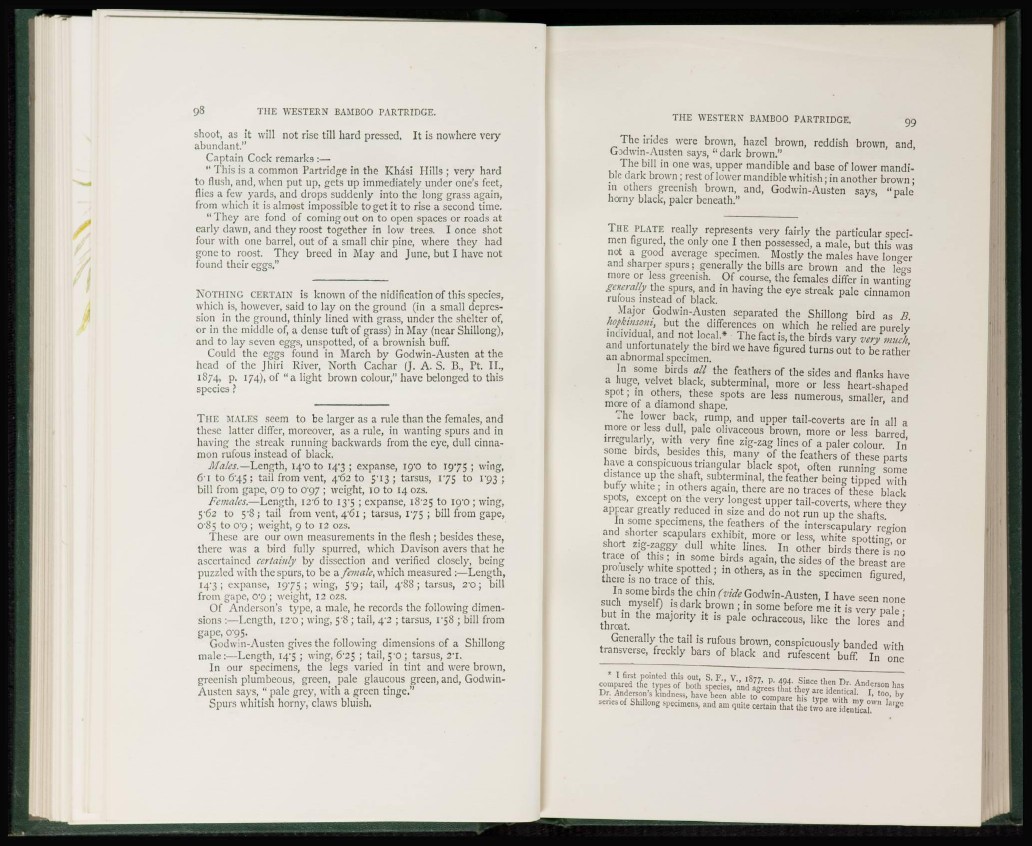
shoot, as it will not rise till hard pressed. It is nowhere veryabundant."
Captain Cock remarks :—
" This is a common Partridge in the Khdsi Hills ; very hard
to flush, and, when put up, gets up immediately under one's feet,
flies a few yards, and drops suddenly into the long grass again,
from which it is almost impossible to get it to rise a second time.
" They arc fond of coming out on to open spaces or roads at
early dawn, and they roost together in low trees. I once shot
four with one barrel, out of a small chir pine, where they had
gone to roost. They breed in May and June, but I have not
found their eggs."
NOTHING CERTAIN is known of the nidification of this species,
which is, however, said to lay on the ground (in a small depression
in the ground, thinly lined with grass, under the shelter of,
or in the middle of, a dense tuft of grass) in May (near Shillong),
and to lay seven eggs, unspotted, of a brownish buff.
Could the eggs found in March by Godwin-Austen at the
head of the Jhiri River, North Cachar (J. A. S. B„ Pt. II.,
1874, p. 174), of " a light brown colour," have belonged to this
species ?
T H E MALES seem to be larger as a rule than the females, and
these latter differ, moreover, as a rule, in wanting spurs and in
having the streak running backwards from the eye, dull cinnamon
rufous instead of black.
Males.— Length, 14-0 to 14-3 ; expanse, ic/o to 1975 ; wing,
61 to 645 ; tail from vent, 4-62 to 513 ; tarsus, 175 to 1-93 ;
bill from gape, C 9 to C97 ; weight, 10 to 14 ozs.
Females.—Length, I2'6 to 13*5 ; expanse, i8'25 to I9'0 ; wing,
5'62 to 5'8 ; tail from vent, 4'<5l ; tarsus, 175 ; bill from gape,
O'Sj to o p ; weight, 9 to 12 ozs.
These are our own measurements in the flesh ; besides these,
there was a bird fully spurred, which Davison avers that he
ascertained certainly by dissection and verified closely, being
puzzled with the spurs, to be a female, which measured :—Length,
I4'3 ; expanse, 1975; wing, 5^9; tail, 4'88 ; tarsus, 2'0; bill
from gripe, o'9 ; weight, 12 ozs.
Of Anderson's type, a male, he records the following dimensions
:—Length, I2'0 ; wing, 5'8 ; tail, 4'2 ; tarsus, 1-58 ; bill from
gape, 0-95.
Godwin-Austen gives the following dimensions of a Shillong
male:—Length, 14-5 ; wing, 6'25 ; tail, 5-0; tarsus, 2'I.
In our specimens, the legs varied in tint and were brown,
greenish plumbeous, green, pale glaucous green, and, Godwin-
Austen says, " pale grey, with a green tinge,"
Spurs whitish horny, claws bluish.
THE WESTERN BAMBOO PARTRIDGE. 9 9
The irides were brown, hazel brown, reddish brown, and
Godwin-Austen says, " dark brown."
The bill in one was, upper mandible and base of lower mandible
dark brown ; rest of lower mandible whitish; in another brown •
in others greenish brown, and, Godwin-Austen says, "pale
horny black, paler beneath."
T H E PLATE really represents very fairly the particular specimen
figured, the only one I then possessed, a male, but this was
not a good average specimen. Mostly the males have longer
and sharper spurs; generally the bills are brown and the legs
more or less greenish. Of course, the females differ in wanting
generally the spurs, and in having the eye streak pale cinnamon
rufous instead of black.
Major Godwin-Austen separated the Shillong bird as B.
hopkinsoni, but the differences on which he relied are purely
individual, and not local.* The fact is, the birds vary very much,
and unfortunately the bird we have figured turns out to be rather
an abnormal specimen.
In some birds all the feathers of the sides and flanks have
a huge, velvet black, subterminal, more or less heart-shaped
spot; in others, these spots are less numerous, smaller, and
more of a diamond shape.
The lower back, rump, and upper tail-coverts are in all a
more or less dull, pale olivaceous brown, more or less barred,
irregularly, with very fine zig-zag lines of a paler colour. In
some birds, besides this, many of the feathers of these parts
have a conspicuous triangular black spot, often running some
distance up the shaft, subterminal, the feather being tipped with
buffy white; in others again, there are no traces of these black
spots, except on the very longest upper tail-coverts, where they
appear greatly reduced in size and do not run up the shafts.
In some specimens, the feathers of the interscapulary region
and shorter scapulars exhibit, more or less, white spotting, or
short zig-zaggy dull white lines. In other birds there is no
trace of this ; in some birds again, the sides of the breast are
profusely white spotted ; in others, as in the specimen figured,
there is no trace of this.
In some birds the chin (vide Godwin-Austen, I have seen none
such myself) is dark brown ; in some before me it is very pale ;
but in the majority it is pale ochraceous, like the lores and
throat.
Generally the tail is rufous brown, conspicuously banded with
transverse, freckly bars of black and rufescent buff. In one
* I first pointed this out, S F V tS7t r, o- ~
compared the types of both species and1L£ t | 9 , t (
D r ' A n t'=rson has
Dr; Anderson's kindness, have been aWe to8 com Dare his7 Zl '' t0°' ^
senes of Shillong specimens, and am n u i t e ' c e r t a n rK the &l^LgT"